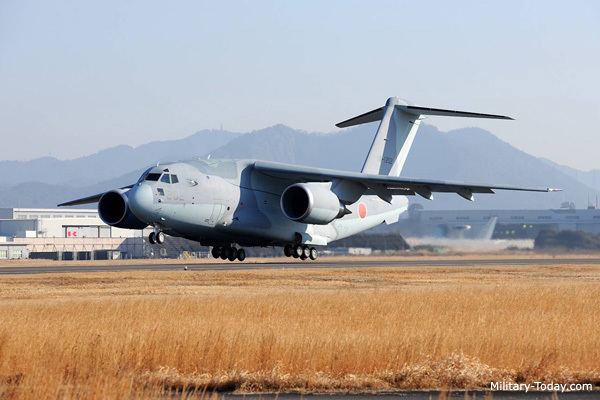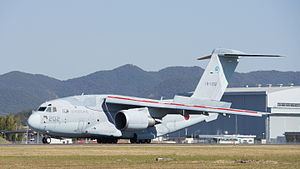Length 44 m Wingspan 44 m Weight 60,800 kg | Range 10,000 km Cruise speed 890 km/h Engine type General Electric CF6 | |
 | ||
Unit cost 120,000,000–120,000,000 USD | ||
Japan jasdf kawasaki c 2 xc 2 first flight 26 january 2010
The Kawasaki C-2 (previously XC-2 and C-X) is a mid-size, twin-turbofan engine, long range, high speed military transport aircraft developed and manufactured by Kawasaki Aerospace Company. In March 2016, the C-2 formally entered service with the Japan Air Self-Defense Force (JASDF).
Contents
- Japan jasdf kawasaki c 2 xc 2 first flight 26 january 2010
- Development
- Design
- Operational history
- Overseas sales
- Specifications C 2
- References

Development

After researching foreign aircraft such as the C-130J Super Hercules, C-17 Globemaster III, and Airbus A400M, the Japanese Ministry of Defense concluded that there was no aircraft in production that possessed the capabilities that the JASDF required. In response to this need, the Japanese MOD commenced the production of plans to develop an indigenously designed and manufactured transport aircraft. In 1995, Kawasaki appealed to the Japanese Defense Agency (JDA) to issue funding for the development of a domestically-built C-X transport aircraft. In 2000, the JDA began forming its requirement for the replacement military airlifer; early determinations for the proposed project included that it would be powered by turbofan engines, possess the range to reach Hawaii from Japan, and carry double the payload of the C-130.

In May 2001, the MOD formally issued a request for proposals in regards to the new transport aircraft, referred to as the C-X program; at the time, the MOD planned to procure 40 aircraft to replace its aging Kawasaki C-1 and C-130 Hercules fleets. In December 2001, it was announced that Kawasaki Aerospace Company, the aerospace division of Kawasaki Heavy Industries, had been selected by the JDA as the prime contractor to develop the C-X.

Kawasaki developed the C-X in parallel with the P-X, which it had also been selected to develop. As a cost saving measure, major airframe parts and system components were shared between the two aircraft. They use the same basic wing structure, although it is installed at different sweep angle and dihedral on the two versions, with different high lift devices and powerplant attachments. Common components include the cockpit windows, outer wings, horizontal stabilizer, and other systems. Internal shared parts include the auxiliary power unit, cockpit panel, flight control system computer, anti-collision lights, and gear control unit. As of 2007, the total development cost for the two aircraft has been 345 billion yen (or roughly equal to $2.9 billion), which is low compared to similar programs. As an example: the development contract for the Boeing P-8 Poseidon alone was $3.89 billion.
Several powerplants were considered for the C-X, including the Rolls-Royce Trent 800, the General Electric CF6-80C2L1F and the Pratt & Whitney PW4000. In May 2003, Ishikawajima-Harima Heavy Industries (IHI) announced its support of General Electric's CF6-80C2L1F engine, having formed an arrangement to locally manufacture the powerplant. That same year, the CF6-80C2L1F was selected to power the type. In August 2003, it was announced that the C-X project had passed a preliminary JDA design review, allowing for prototype manufacturing to proceed.
During the construction of the first prototype, there was a problem discovered with some American-made rivets which delayed the roll-out to 4 July 2007 along with its cousin aircraft P-X (since designated as the P-1). During structural testing, deformation of the XP-1 / XC-2 horizontal stabiliser was found, as well as cracking in the XC-2 undercarriage trunnion structure and parts of the fuselage; the cracking problem was reportedly difficult to address. The C-X program was embroiled in further controversy when allegations that bribery had been involved in the purchase of five General Electric CF6-80C2 engines, used to power the aircraft, were made by prosecutors.
In 2008, according to the Chunichi Shimbun, the C-2 was set to cost about 10 billion yen per aircraft (about US$80 million). Postponement of the F-X program and the need to increase funding of the F-15J fleet modernisation program have necessitated the implementation of a one-year delay in the C-X program. In 2014, the aircraft was delayed again following the failure of the rear cargo door during pressure tests. The delay will increase the program cost by 40 billion yen ($390 million) to 260 billion yen in addition to delays to the program. In March 2016, it was reported that the C-2 program faced delays of five years from its initial schedule due to technical problems, while development costs were then estimated to hit ¥264.3 billion, ¥80 billion more than initially projected.
Kawasaki has also studied the development of a civil-orientated version of the C-2 with ambitions to sell the type to commercial operators. This variant, tentatively designated as the YC-X, little modification is envisioned from the C-2, making use of transferrable technologies from the military airlifter, although the intended payload is likely to be increased from the C-2's 26-ton maximum to 37-tons. In 2007, it was stated that the development of a civilian derivative of the C-2 has been given a lower priority than the completion of the military airlifter. In late 2012, Kawasaki was in the process of consulting potential customers on the topic of the YC-X for transporting outsize cargo; based upon customer feedback, Kawasaki forecast an estimated demand for up to 100 freighters capable of handling bulky cargoes between 2020 and 2030.
Design
The Kawasaki C-2 is a long range twin-engine transport aircraft. In comparison with the older C-1 that it replaces, the C-2 can carry payloads up to four times heavier, such as MIM-104 Patriot surface-to-air missile (SAM) batteries and Mitsubishi H-60 helicopters, and possesses six times the range.
The C-2 is being developed to meet the following requirements of the Ministry of Defense: a minimum payload of 26 tonnes, 120 metric ton (264,552 lb 132.275 short ton) take-off weight, ability to takeoff/land on short runways, (Requirement: 500m, almost same as C-1, e.g. Tachikawa—900 m, Kamigoto—800 m, Hateruma—800 m), a maximum payload of 37,600 kg whilst taking off from a 2,300 m Take-off Field Length at a 141 tonnes (310,851 lb 155.42 short ton) take-off weight, ability to fly international airroutes (Requirement: Mach 0.8+; JDA ruled out C-17 as a candidate by its lower cruising speed. Conventional cargo aircraft cannot cruise at optimum altitude on commercial airroutes because of their lower cruising speed and are often assigned to lower altitude by ATC.), in-flight aerial refuelling and forward looking infrared systems.
The C-2 is powered by a pair of General Electric CF6-80C2K turbofan engines. While sharing fuselage components with the Kawasaki P-1, the fuselage of the C-2's is substantially larger to accommodate a vast internal cargo deck, which is furnished with an automated loading/unloading system to reduce workloads on personnel and ground equipment. The forward fuselage and horizontal stabilizer is made of an internally-designed composite material, KMS6115. A tactical flight management system and head-up display is installed to reduce the challenges involved in flying at low altitudes or close to mountainous terrain. The C-2 is equipped with a full glass cockpit, fly-by-wire flight controls, a high-precision navigation system, and self protection systems.
Operational history
On 26 January 2010, the maiden flight of the XC-2 took place from Gifu Air Field, Chūbu region, Japan; this first flight was reportedly carried out without any problems occurring. Prior to the first flight, the aircraft was re-designated as the C-2. On 30 March 2010, the first aircraft was delivered to the Japanese Ministry of Defence.
On 24 February 2016, 1st prototype "08-1201" was redelivered from reinforced body exchange programme, and 2nd prototype "18-1202" is undergoing the programme from May.
In March 2016, the JASDF announced that the C-2 airlifter had formally entered operational service.
On 30 June 2016, 1st production model "68-1203" was delivered to Air Development and Test Wing at Gifu Air Field.
On 20 October 2016, the maiden flight of 2nd production model "68-1204" was held.
Overseas sales
Kawasaki has been reportedly keen to seek sales of the C-2 to overseas customers in addition to the domestic market. In the strategic airlift role, the C-2 is one of only a few aircraft in production that can perform its role; others include the Airbus A400M Atlas and the Ilyushin Il-76, and thus has few competitors on the world market. In response to plans by the Japanese government to lower historic defense export restrictions, Kawasaki began actively promoting the C-2 to foreign customers in 2015. New Zealand has expressed interest in the aircraft for the Royal New Zealand Air Force and also in the Kawasaki P-1 maritime patrol aircraft.
Specifications (C-2)
Data from Japanese Ministry of Defense Flight International ATLA
General characteristics
Performance
